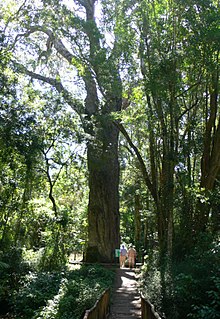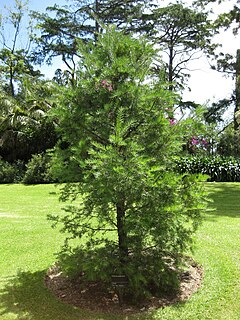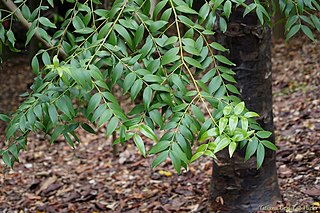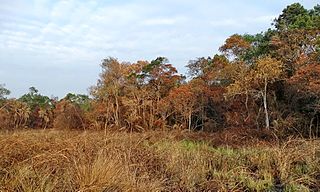
Nageia is a genus of conifers belonging to the podocarp family Podocarpaceae. Nageia includes evergreen shrubs and trees, from one to 54 meters in height. A 2009 treatment of the genus recognized five species. Some authors consider Nageia formosensis to be a separate species from Nageia nagi, thus recognizing six species. The podocarp genera have been reshuffled by various botanists. Most recently, several species formerly classed as Nageia were moved to the new genus Retrophyllum, while Nageia falcata and Nageia mannii were moved to the new genus Afrocarpus.

Afrocarpus is a genus of conifers of the family Podocarpaceae. Two to six species are recognized. They are evergreen trees native to Africa. Afrocarpus was designated a genus in 1989, when several species formerly classified in Podocarpus and Nageia were reclassified.

Cupressus dupreziana, the Saharan cypress, or tarout, is a very rare coniferous tree native to the Tassili n'Ajjer mountains in the central Sahara desert, southeast Algeria, where it forms a unique population of trees hundreds of kilometres from any other trees. There are only 233 specimens of this endangered species, the largest about 22 m tall. The majority are estimated to be over 2000 years old, with very little regeneration due to the increasing desertification of the Sahara. Rainfall totals in the area are estimated to be about 30 mm annually. The largest one is named Tin-Balalan is believed to be the oldest tarout tree with a circumference of 12 meters or 36 feet.

Cupressus guadalupensis, the Guadalupe cypress, is a species of cypress from Guadalupe Island in the Pacific Ocean off western North America.

Phyllocladus aspleniifolius, commonly known as the celerytop pine, is an endemic gymnosperm of Tasmania, Australia. It is widespread and common in Tasmania, with the most abundance in the western highlands. Its ‘leaves’ appear similar to those of a celery plant, hence the common name.

Cupressus lusitanica, ; cedro blanco means white cedar and is also known as Mexican white cedar or cedar-of-Goa, is a species of cypress native to Mexico and Central America. It has also been introduced to Belize, Costa Rica and Nicaragua, growing at 1,200–3,000 metres (3,900–9,800 ft) altitude.

Cupressus funebris, the Chinese weeping cypress, is a species of cypress native to southwestern and central China. It may also occur naturally in Vietnam.

Afrocarpus falcatus is a species of tree in the family Podocarpaceae. It is native to the montane forests of southern Africa, where it is distributed in Malawi, Mozambique, South Africa, and Eswatini. Common names include common yellowwood, bastard yellowwood, outeniqua yellowwood, African pine tree, weeping yew, Afrikaans: outeniekwageelhout, kalander, Sotho: mogôbagôba, Xhosa: umkhoba and Zulu: umsonti. It is widespread, in some areas abundant, and not considered threatened, but it is a protected tree in South Africa. It is grown as an ornamental tree, especially in South Africa, and occasionally abroad.

Afrocarpus gracilior is a species of coniferous tree in the family Podocarpaceae known as benet in Marakwet and East African yellowwood, African fern tree, or bastard yellowwood in English

Afrocarpus mannii is an evergreen coniferous tree native to the Afromontane forests of São Tomé Island in the Gulf of Guinea, growing at altitudes of 1,300 m up to the summit at 2,024 m. It was formerly classified as Podocarpus mannii.

Cupressus torulosa, commonly known as the Himalayan cypress or Bhutan cypress, is a species of cypress tree native to the mountainous northern regions of the Indian subcontinent, primarily the Himalayas.

Keteleeria evelyniana is a species of conifer native to southern China, Laos and Vietnam. It can become 40 metres (130 ft) tall.
Afrocarpus usambarensis is a species of conifer in the family Podocarpaceae. The tree is endemic to Tanzania, in Afromontane habitats.

Agathis atropurpurea, the black kauri or blue kauri, is a species of conifer in the family Araucariaceae. It is found only in Queensland, Australia and is threatened by habitat loss.

Araucaria humboldtensis, or Humboldt's araucaria, is a species of conifer in the family Araucariaceae. It is found only in New Caledonia. It is threatened by habitat loss, as even though the remaining wild populations are located within protected park areas, an increased frequency of forest fires in recent years has led to continued degradation of habitat and increased dieback of mature trees.

Araucaria luxurians is a species of conifer in the family Araucariaceae. It is known by the common names Sapin de Noël and Coast araucaria. It is endemic to New Caledonia, where it grows in several small subpopulations. It grows in ultramafic soils in humid forests and on cliffs and slopes. It is threatened by habitat loss and none of the subpopulations are in protected areas.

Baikiaea insignis is a species of legume in the family Fabaceae.

The Minziro (Nature) Forest Reserve is a 24,841 ha conservation area along the Kagera River in Bukoba district of northwestern Tanzania. It protects one of the largest forests in Tanzania, of a forest type that is unique in the country. It was gazetted in 1947 and is situated at around 1,150 metres a.s.l. in fairly level terrain. The forest is continuous with the Malabigambo Forest over the nearby Uganda border. The largest part consists of Baikiaea–Podocarpus seasonal swamp forests while the remainder is flooded acacia woodlands.

The Victoria Basin forest–grassland mosaic is an ecoregion that lies mostly in Uganda and extends into neighboring countries. The ecoregion is centered north and west of Lake Victoria, with an outlier on the border of Ethiopia and South Sudan.
The Sango Bay forests are distinctive forests found in southwestern Uganda, near the border with Tanzania. The Sango Bay forests grow on seasonally-flooded lowlands near on the lower reaches of the Kagera River, just west of where it empties into Lake Victoria.


















